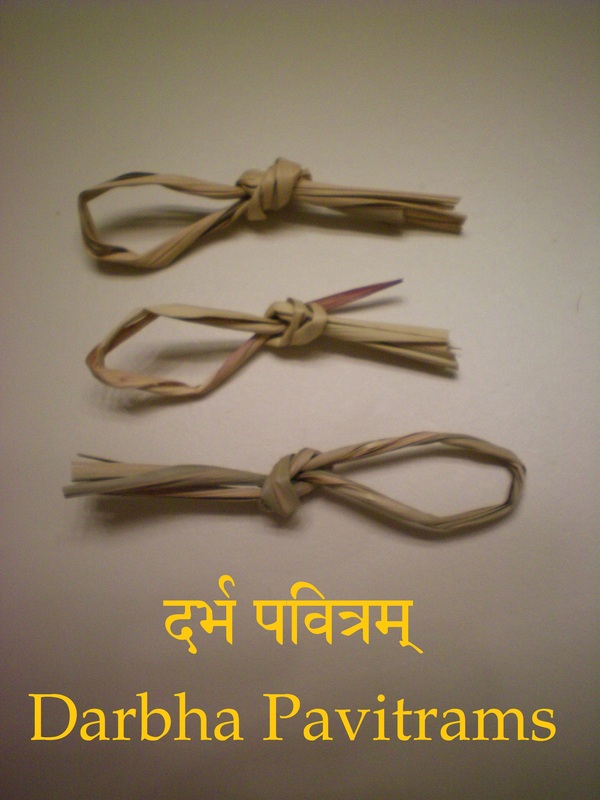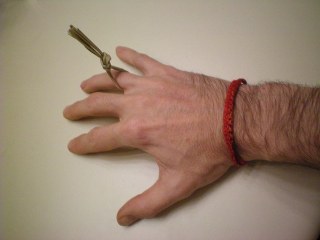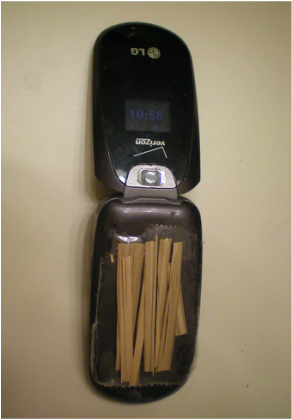Spiritual Uses
Darbha is used for making āsanas (seats for prayer and meditation). Traditionally, the seat of darbha grass is covered with another āsana of wool, silk, cotton or animal skin. A darbhāsana aids in meditation and protects the person who sits on it from all sorts of negative spiritual energies. If a darbhāsana is not available, a few blades of darbha grass can be placed under the seat for similar effects.
Darbha is traditionally strewn around the place where yajña (fire ceremony), pūjā (prayer ritual) and other religious rituals are conducted. This protects the people praying from negative spiritual influences and helps to open a channel for connecting with the Devas.
Kūrcas (bundles) of Darbha grass are placed in the kumbhas (sacred water pot images) where the Devas are invoked for worship. Darbha kūrcas used in this way help to create a channel to the realm of the Devas while shielding from influences from the lower astral realms, and they also amplify the power of the prayers.
During Kumbhābhiṣekam rituals (rituals of Temple consecration), water is kept in kumbhas (water pots). The Devas are invoked into the water pot and worshiped with yantra puja (mystical diagrams), upacāras (ritual offerings) and homam (fire ceremony). This process energizes the water in the kumbhas, which is then used in a ritual bath to purify and energize (or re-energize) the Temple murtis (icons). During this process a thread is woven from darbha grass to connect the kumbha (water pot) to the Vigrahas (Temple Icons).
During āvāhana rituals (invocation), the kumbha (water pot), Bimba (statue), or chitrapaṭa (photo) used for worship is touched with a darbha kūrca, along with mantras of invocation. During Prāṇa Pratiṣṭhā rituals (rituals of enlivenment) for the consecration of a new Murti (Icon), the image is touched with darbha kūrcas at various places, accompanied by special mantras. Darbha Pavitram (rings made from darbha), are worn by priests (or at home) whenever prayer rituals are conducted. These rings help to shield the wearer from negative spiritual energies and to energize their prayers. During Sankalpa (ritual of announcing to the Devas what and who the rituals being conducted are for), the wife maintains an energetic connection to the husband, by touching him with a darbha kūrca. 
During Vivāham (wedding rituals), the woman wears a belt tied from darbha grass.
Similarly, a belt made of darbha is tied around the waist of brahmacāris (spiritual aspirants) during upanāyanam (rituals of spiritual initiation).
During Yajña (fire ceremonies), darbha is placed inside thehoma kuṇḍa (fire altar) before the sacred fire is lit and on the four sides of the homa kuṇḍa along with mantras to protect from negative energies and empower the rituals.
Upon the completion of a homam (fire ceremony), blades of darbha are burnt with special mantras. The black ash is then mixed with ghee and blessed with mantras before this black ash (called rakṣa) is offered to devotees to transfer blessings from the rituals. Darbha is very important in rituals of purification (puṇyā-havācanam) when it is kept in kumbha (water pots) to enhance the purifying qualities of the water. This water is energized with Vedic mantras while touching the kumbha with kūrcas (bundles) made of darbha. Darbha is considered a must in rituals for the Pitṛs (Ancestors) like tarpanam. The ancestors are invoked using bundles of darbha and offerings of water and black sesame are made pouring from the hand, through blades of darbha.
Household Uses
Darbha is used medicinally in āyurveda as a cooling diuretic and urinary tonic. It has been used to treat urinary dis-eases, diabetes, epilepsy, piles, dysentery, and heavy and prolonged menstruation. It is used to treat repeated abortion and spiritual disorders of all types. It is used to improve the complexion and to treat internal and external wounds. It also has tonic effects to help in emaciation, severe debility or after serious illnesses. Darbha is traditionally used to protect cooked foods from toxic radiation during eclipse. During solar and lunar eclipses, the atmosphere is full of toxic radiation. It is said that cooked food kept during an eclipse will become toxic. If cooked foods are covered in a container and darbha grass kept on top, the darbha will shield the food from toxic rays.
A few blades of darbha can be soaked in water and the water poured over the head or drunk for purifying the body spiritually. This water may also be sprinkled around the home, vehicle, or workplace to purify the space from negative spiritual vibrations and to protect from ghosts, demons, and black magic. Darbha grass can be strewn around or in the home to protect from thieves, accidents or the ill-intentions of enemies. Darbha kept within the home helps to reduce anger and quarrels between family members. Darbha blades can be strewn under the mattress to protect a person from radiation, ghosts and negative spiritual energies while sleeping. Darbha can be strewn around large electrical appliances to help shield people from electric radiation. This is especially useful for people who work for long hours around computers or other machines.
Small pieces of darbha can be taped to cell phones to help absorb radiation. Darbha used for absorbing negative radiation should be changed regularly to ensure efficacy. Darbha can be kept in the vehicle to protect from radiation from electrical equipment (like radio-waves, internet and phone signals and power-lines). Darbha kept in the car also protects the car from accidents and negative spiritual energies.Darbha pavitrams can be worn or some small pieces of darbha carried with someone to protect from negative energies, enemies, snakes, attacks and accidents when traveling. Darbha pavitrams can be worn or pieces of darbha kept with a person while meditating or doing healing work to enhance these practices and to protect from negative energies.
A Few Guidelines for Using Darbha
- For the best results, blades of darbha with the tips intact should be used.
- When cutting darbha into smaller pieces, do not use the finger nails, and keep the tips intact if possible.
- Handle darbha with reverence and respect for its spiritual energies.
- When strewing Darbha, keep its tips pointing toward the East, North, or North East.
- Darbha kūrcas (bundles) should consist of 7, 9, 16, 18, 21, 24, 27 or other sacred numbers for best results.
- Darbha pavitrams (rings) should be made with 1 blade for antyeṣṭi (funerals and other rituals of death); with 2 blades for nitya pūjā (regular, home worship offered for oneself and family); with 3 blades for pitṛ pūjā (rituals for the ancestors like tarpaṇam and śrāddham); and with 4 blades for parārtha pūjā (Temple worship / prayers for others).
- After gathering, darbha should be used ideally within six months for best results.
- Darbha should be gathered by spiritually-minded people, while chanting mantras.
- Darbha should be gathered only on the first lunar day of the waning moon cycle.
- After use, darbha should not be re-used, but discarded respectfully in a natural place where people will not walk.
- Darbha water should be ideally used within 24 hours.
- If darbha is not available, other grasses, especially those in the Desmostachya, and Eragrostis genera, or lemon-grass and its relatives can be substituted. These grasses will have lesser but adequate effects. Be careful when handling grasses, because many have razor-sharp edges which can cut the fingers if a person is not careful (lemongrass is a great example of this).
- To store darbha or other grasses, ensure they are dried well to prevent mold, and store ideally in an airtight container or bag.